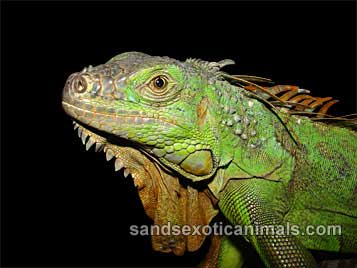
Origin:
Elevations below 3,000 feet in tropical regions from northern Mexico to central South America, often found in the vicinity of rivers and streams.Description:
Iguanas have short, powerful limbs equipped with sharp claws (for climbing and digging) and a long, strong tail. A large flap of skin (the dewlap) hangs from the throat and helps regulate body temperature. Iguanas also have a prominent crest of soft spines along the mid-line of the neck and back beginning at the base of the skull. Male iguanas tend to be larger and have brighter coloration than females. Iguanas can defend themselves with quick, whip-like lashes of their tails. Iguanas can reach lengths of 6 to 6 1/2 feet.Feeding:
Young iguanas should be fed daily. Vegetables (broccoli, spinach, mustard and turnip greens, romaine lettuce, etc.) should be chopped into a size that can be easily handled by the young iguana. Sprinkle with a vitamin-mineral supplement. Growing iguanas may also be fed guinea pig or rabbit pellets (the pellets should be mixed with water and allowed to expand) either plain or as a topping over the vegetables. This is an easy way to add necessary vitamins and minerals to the iguana's diet. Fresh fruit can occasionally be included in the diet. Water should be available at all times for drinking and bathing.Housing:
Iguanas can be kept in all glass enclosures with screen tops or custom built wood enclosures. Iguanas like to be able to hide in hide boxes or even cardboard boxes. Iguanas are somewhat clumsy but accomplished tree climbers. A basking branch is a great addition for an iguana.Lighting:
Iguanas need to be exposed to direct sunlight to properly absorb dietary calcium. A shaded area should be provided so the iguana can avoid a heat stroke from overexposure to sunlight. Lamps may be used for basking.Temperature:
Iguanas require a warm temperature to raise their body temperature and increase their activity level. Iguanas do quite well when a heating pad or heat rock is provided. The iguana has the option of lying on this object (partially or totally) to obtain heat as needed. The optimal temperature is between 85 and 103 degrees Fahrenheit. A thermometer is recommended to monitor the temperature.
Compliments of:
S & S Exotic Animals, Inc., 1711 Connorvale, Houston, TX 77039 (281) 590-0426
http://www.sandsexoticanimals.com
